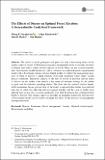Files in this item
The effects of disease on optimal forest rotation : a generalisable analytical framework
Item metadata
| dc.contributor.author | Macpherson, Morag F. | |
| dc.contributor.author | Kleczkowski, Adam | |
| dc.contributor.author | Healey, John R. | |
| dc.contributor.author | Hanley, Nick | |
| dc.date.accessioned | 2016-11-11T10:30:16Z | |
| dc.date.available | 2016-11-11T10:30:16Z | |
| dc.date.issued | 2018-07 | |
| dc.identifier | 247569148 | |
| dc.identifier | 0476f0e8-8859-4d81-845c-8220e869182b | |
| dc.identifier | 000436422800001 | |
| dc.identifier | 85052972554 | |
| dc.identifier.citation | Macpherson , M F , Kleczkowski , A , Healey , J R & Hanley , N 2018 , ' The effects of disease on optimal forest rotation : a generalisable analytical framework ' , Environmental and Resource Economics , vol. 70 , no. 3 , pp. 565-588 . https://doi.org/10.1007/s10640-016-0077-4 | en |
| dc.identifier.issn | 0924-6460 | |
| dc.identifier.uri | https://hdl.handle.net/10023/9807 | |
| dc.description | This work is from the project titled Modelling economic impact and strategies to increase resilience against tree disease outbreaks. This is one of seven projects in the Tree Health and Plant Biosecurity Initiative (phase 2) funded by BBSRC, Defra, ESRC, Forestry Commission, NERC and Scottish Government. | en |
| dc.description.abstract | The arrival of novel pathogens and pests can have a devastating effect on the market values of forests. Calibrating management strategies/decisions to consider the effect of disease may help to reduce disease impacts on forests. Here, we use a novel generalisable, bioeconomic model framework, which combines an epidemiological compartmental model with a Faustmann optimal rotation length model, to explore the management decision of when to harvest a single rotation, even-aged, plantation forest under varying disease conditions. Sensitivity analysis of the rate of spread of infection and the effect of disease on the timber value reveals a key trade-off between waiting for the timber to grow and the infection spreading further. We show that the optimal rotation length, which maximises the net present value of the forest, is reduced when timber from infected trees has no value; but when the infection spreads quickly, and the value of timber from infected trees is non-zero, it can be optimal to wait until the disease-free optimal rotation length to harvest. Our original approach provides an exemplar framework showing how a bioeconomic model can be used to examine the effect of tree diseases on management strategies/decisions. | |
| dc.format.extent | 24 | |
| dc.format.extent | 1009362 | |
| dc.language.iso | eng | |
| dc.relation.ispartof | Environmental and Resource Economics | en |
| dc.subject | Bioeconomic modelling | en |
| dc.subject | Disease | en |
| dc.subject | Faustmann | en |
| dc.subject | Forest management | en |
| dc.subject | Forestry | en |
| dc.subject | Optimal rotation length | en |
| dc.subject | HD28 Management. Industrial Management | en |
| dc.subject | GE Environmental Sciences | en |
| dc.subject | Aerospace Engineering | en |
| dc.subject | Management, Monitoring, Policy and Law | en |
| dc.subject | T-NDAS | en |
| dc.subject.lcc | HD28 | en |
| dc.subject.lcc | GE | en |
| dc.title | The effects of disease on optimal forest rotation : a generalisable analytical framework | en |
| dc.type | Journal article | en |
| dc.contributor.sponsor | BBSRC | en |
| dc.contributor.institution | University of St Andrews. School of Geography and Geosciences | en |
| dc.contributor.institution | University of St Andrews. Geography & Sustainable Development | en |
| dc.identifier.doi | 10.1007/s10640-016-0077-4 | |
| dc.description.status | Peer reviewed | en |
| dc.identifier.grantnumber | BB/L012561/1 | en |
This item appears in the following Collection(s)
Items in the St Andrews Research Repository are protected by copyright, with all rights reserved, unless otherwise indicated.

